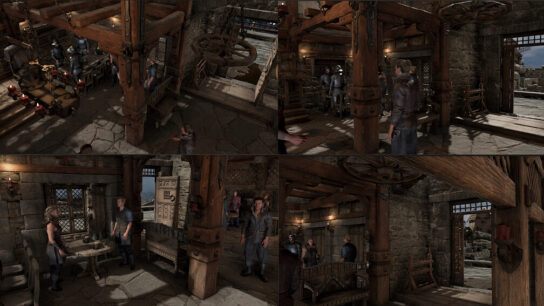Published by: admin
Learning to use Unreal Engine can be a daunting task for those who are new to game development. But is an unreal engine easy to learn?
With the right resources and dedication, anyone can become proficient in this powerful tool used by developers around the world.
By taking advantage of masterclass.com’s comprehensive tutorials and tips on getting started with Unreal Engine, you’ll soon understand why many consider it one of the most user-friendly gaming engines available today – so yes, is unreal engine easy to learn?
Let’s find out!
Overview of Unreal Engine


Unreal Engine (UE4) is a game engine developed by Epic Games, first released in 1998. It is used to create interactive 3D applications such as video games, architectural visualizations, and simulations.
UE4 has become one of the most popular engines among developers due to its powerful features and scalability.
What is Unreal Engine?
Unreal Engine (UE4) is a game engine developed by Epic Games that enables users to create high-quality 3D applications such as video games, virtual reality experiences, architectural visualizations, and simulations.
It was initially released in 1998 but has since been updated with new features and technology over the years. UE4 provides an intuitive interface for developers to quickly build complex projects without needing extensive programming knowledge or experience.
The engine also supports multiple platforms including Windows PC, Mac OS X, iOS/Android devices, Xbox One/PS4 consoles, and more.
Benefits of Learning Unreal Engine
Learning how to use Unreal Engine can open up many opportunities for aspiring game developers or those looking to break into the industry.
With UE4’s wide range of tools and features, it allows users to easily create stunning visuals while still maintaining performance on all platforms they are targeting their project at.
Additionally learning how this powerful tool works will give you a better understanding of what goes into creating immersive gaming experiences which could be beneficial when developing your own projects or working on other people’s work professionally in the future.
The popularity of Unreal Engine
Since its initial release in 1998, Unreal Engine has grown exponentially in popularity among both professional studios and independent developers alike.
This growth can be attributed largely due to its scalability, robust feature set, cross-platform support, ease of use, affordability, and the ability for anyone with basic coding skills and access to online tutorials to learn how to utilize it effectively.
As a result, there have been numerous successful titles created using UE4 ranging from indie hits like Cuphead and Hollow Knight all the way up to triple-A franchises like Gears Of War and Fortnite Battle Royale.
Unreal Engine is an incredibly powerful and popular game engine that can offer a range of benefits for learning game development.
With the right resources, it can be easy to get started with Unreal Engine – let’s look at what you need to know in order to get up and running quickly.
Key Takeaway: Unreal Engine (UE4) is a powerful game engine that enables users to create high-quality 3D applications such as video games, virtual reality experiences, architectural visualizations, and simulations. It offers many benefits for developers such as scalability, robust feature set, cross-platform support and ease of use. Additionally its popularity has grown significantly due to its affordability and ability for anyone with basic coding skills to learn how to utilize it effectively resulting in numerous successful titles being created using UE4.
Getting Started with Unreal Engine
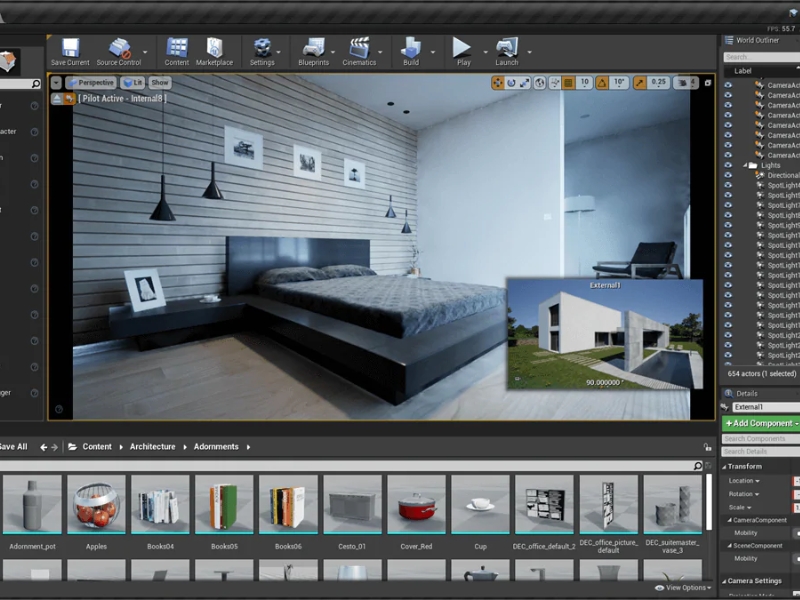

Prerequisites for Learning Unreal Engine: Before getting started with Unreal Engine, it is important to understand the basics of 3D modeling and animation.
It is also helpful to have a basic understanding of game design principles such as level design, scripting, and optimization.
Additionally, having some experience with C++ programming can be beneficial when working on more advanced projects in UE4.
Resources for Learning Unreal Engine: There are many resources available online for learning Unreal Engine.
The official website offers tutorials and documentation that cover all aspects of the engine from beginner topics like setting up your project to more advanced topics like creating cinematics or optimizing performance.
Additionally, there are numerous video tutorials available on YouTube that provide step-by-step instructions for specific tasks in UE4.
Finally, there are several forums dedicated to discussing issues related to UE4 development where users can ask questions and get help from experienced developers.
One way to quickly learn how to use Unreal Engine is by taking advantage of its built-in tools such as Blueprint Visual Scripting, which allows you to create complex systems without writing any code at all.
Additionally, it is important not to get overwhelmed by the amount of information available; focus on one topic at a time so that you do not become overwhelmed or confused by too much information at once.
Finally, take advantage of community resources such as forums where experienced developers can answer questions about specific topics related to UE4 development or even offer advice about best practices when working with the engine itself.
Overall, getting started with Unreal Engine is a great way to begin learning game development. With the right resources and knowledge of the basics, you can quickly become proficient in this powerful engine.
Now let’s look at understanding the basics of Unreal Engine for further progress.
Key Takeaway: Learning Unreal Engine requires a basic understanding of 3D modeling, game design principles, and C++ programming. Resources such as tutorials, documentation, video tutorials, and forums can help you quickly learn how to use the engine. Additionally, take advantage of built-in tools like Blueprint Visual Scripting for complex systems without code.
Understanding the Basics of Unreal Engine
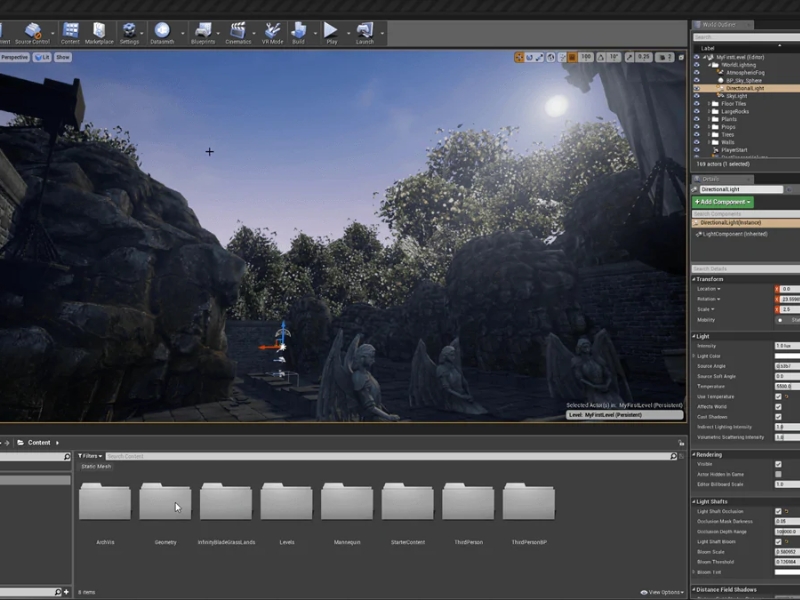

This section will provide an overview of the basics of UE4, including the interface and tools, different components of the editor, and working with assets in the content browser.
The first step in understanding Unreal Engine is familiarizing yourself with its interface and tools.
The main window contains several tabs that allow you to access different features such as materials, textures, meshes, lighting effects, animations, etc. You can also customize your viewport layout for easier navigation through menus or panels.
Additionally, there are many shortcuts available that make navigating around faster and more efficient.
Once you have become comfortable with the interface it’s time to explore some of the different components of UE4’s editor.
These include things like Actors (objects), Materials (textures), Meshes (3D models), Lights & Shadows (lighting effects) as well as Animation Sequences & Events which control how objects move within a scene or level. All these elements come together to form a complete project within Unreal Engine 4’s environment.
Finally, we come to work with assets in UE4’s Content Browser. This allows users to quickly search for existing assets from their library or download new ones from online marketplaces such as Epic Games Store or Unity Asset Store if needed for their projects.
Assets can be organized into folders based on type, making them easy to find when needed later on during the development process.
This helps save time since all related items are kept together in one place rather than scattered across multiple locations.
Although it may seem daunting to learn Unreal Engine, understanding the basics is key in developing projects.
With a firm foundation of the interface and tools, you’ll be ready to dive into creating levels and scenes with Blueprints and C++ code.
Key Takeaway: Unreal Engine (UE4) is a powerful game engine used to create stunning visuals and immersive experiences. Its interface and tools, different components of the editor, as well as assets in the Content Browser, are easy to understand and navigate. Key takeaways: – Interface & Tools – Components of Editor (Actors, Materials, Meshes, etc.) – Working with Assets in Content Browser
Developing Projects with Unreal Engine
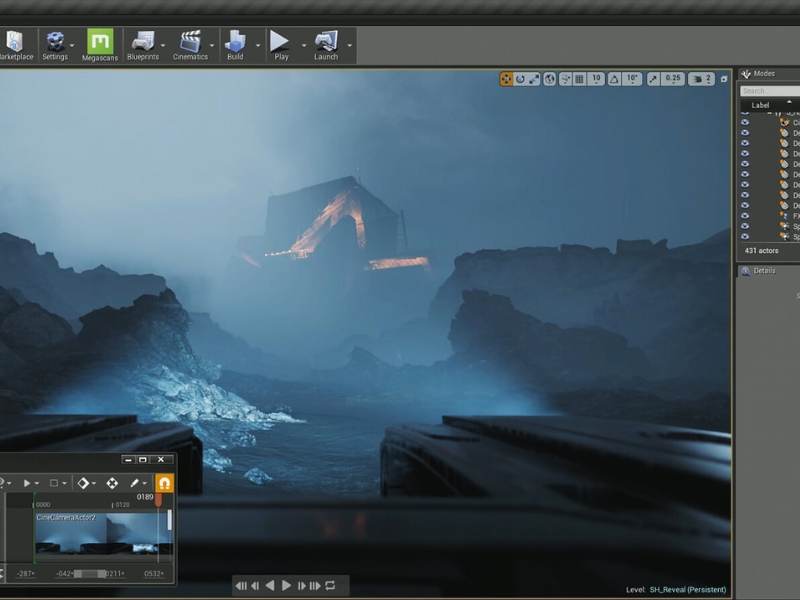

Developing projects with Unreal Engine (UE4) can be a daunting task for beginners, but with the right guidance and resources, anyone can create amazing projects.
This section will cover creating levels and scenes in UE4, working with blueprints and C++ code, optimizing performance and visuals, as well as other aspects of developing projects with UE4.
Creating Levels and Scenes in UE4: Creating levels or scenes is the foundation of any project built using Unreal Engine 4.
It involves setting up basic objects such as walls, floors, ceilings, etc., which are then used to build more complex structures like buildings or environments.
The editor also allows users to add lighting effects to their scene along with textures that give it an aesthetically pleasing look.
Additionally, users have access to various tools within the editor that allows them to customize their level further by adding props or even scripting events into it if they wish.
Working With Blueprints and C++ Code: Blueprints are a visual scripting language used within Unreal Engine 4 which allows users to quickly create game logic without having knowledge of programming languages such as C++ or Python.
By connecting nodes together on a graph-like interface called “Blueprint Editor” users can set up conditions for certain events that occur in their game world such as when an enemy appears on a screen or when the player collects a power-up item etc…
On the other hand, if you do know how to program in languages like C++ then you can use this knowledge alongside blueprints allowing you greater control over your project’s functionality while still taking advantage of all features offered by UE4 itself.
Optimizing performance is essential for any game developed using Unreal Engine 4 since it ensures a smooth gameplay experience regardless of the hardware specifications being used by players running your game on different platforms such as PC/Mac/Consoles etc.
There are several ways one could go about doing this, including reducing draw calls per frame (reducing the number of objects rendered at once), increasing texture resolution settings (for better-looking visuals), and enabling multi-threaded rendering (to take advantage of multiple cores).
All these steps help improve overall performance significantly, making sure players get the best possible gaming experience from your product.
Developing projects with Unreal Engine is an incredibly powerful tool, offering users the ability to create stunning visuals and immersive experiences.
With advanced features like cinematics, AI, physics, networking, and audio effects available through Marketplace assets, UE4 offers a wide range of possibilities for developers.
Key Takeaway: The key takeaway from the above is that developing projects with Unreal Engine (UE4) can be achieved by creating levels and scenes, working with blueprints and C++ code, as well as optimizing performance. This will ensure a smooth gaming experience for players regardless of their hardware specifications.
Advanced Features of Unreal Engine
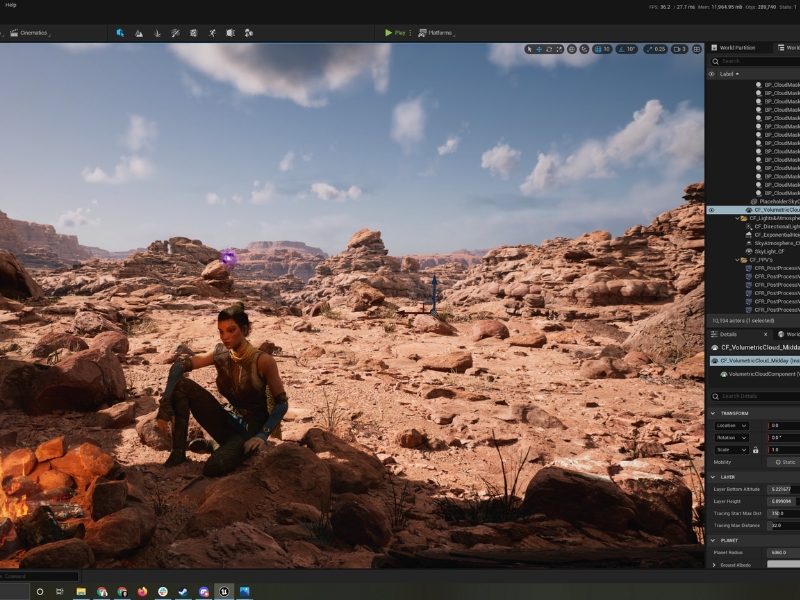

The Unreal Engine is a powerful tool for creating immersive and interactive experiences. It has a wide range of advanced features that can be used to create stunning visuals, realistic physics, complex AI systems, and more.
In this blog post, we’ll take a look at some of the most important advanced features of Unreal Engine 4 (UE4).
Creating Cinematics and Animations in UE4: With UE4’s Sequencer feature, users can create cinematic sequences with ease.
The Sequencer allows users to combine different elements such as cameras, lights, animations, and audio into one timeline-based sequence.
This makes it easy to create dynamic cutscenes or even entire movies within the engine itself. Additionally, UE4 also provides tools for animating characters using inverse kinematics (IK) or motion capture data from external sources.
Artificial intelligence (AI) is an essential part of any game experience today, and UE4 offers many tools for implementing sophisticated AI behaviors into games.
Its Behavior Tree system allows developers to define complex behavior trees that control how NPCs interact with each other or react to player input, while its Navigation Mesh system enables NPCs to move around levels realistically by taking obstacles into account when calculating paths between points in space.
On top of this, there are various physics simulation options available including rigid body dynamics as well as fluid simulations like water ripples or smoke effects which all add another layer of realism to games created with UE4.
Finally, networking capabilities allow players on different devices connected over the internet or local networks to play together in real-time without having to worry about setting up servers themselves thanks to the built-in support for dedicated servers provided by Epic Games’ own online services platform called “Unreal Online Services”
Utilizing Marketplace Assets: To speed up development times further Epic Games provides access to their official marketplace where developers can purchase ready-made assets such as 3D models, textures, sounds, animations, etc.. from professional content creators which they can then use directly inside their projects saving them valuable time during production cycles.
All purchases made through the marketplace are royalty free meaning developers don’t have worry about copyright issues when using these assets either .
Key Takeaway: Unreal Engine 4 (UE4) offers powerful tools for creating immersive and interactive experiences, including Sequencer for cinematics, Behavior Tree and Navigation Mesh systems for AI, physics simulation options, and networking capabilities. Additionally, developers can speed up production times by purchasing ready-made assets from the official marketplace.
FAQs in Relation to Is Unreal Engine Easy to Learn
How long will it take to learn Unreal Engine?
It depends on the individual and their experience level. For a beginner, it can take anywhere from several weeks to several months to learn Unreal Engine. If you have prior knowledge of game development or 3D modeling, then you may be able to learn the basics in as little as a few days. However, mastering all of its features could take much longer depending on how quickly you pick up new concepts and techniques. Regardless of your skill level, MasterClass offers comprehensive courses that will help guide you through learning Unreal Engine step-by-step so that you can become an expert in no time.
Is Unreal Engine beginner friendly?
Yes, Unreal Engine is beginner friendly. It has a comprehensive set of tutorials and resources to help users get started with the engine quickly. Additionally, it offers an intuitive interface that makes learning how to use the engine easier than ever before. The community also provides helpful advice for those just starting out in game development, making it even more accessible for newbies. All in all, Unreal Engine is a great choice for beginners looking to start creating their own games or other interactive projects.
Can I learn Unreal Engine without coding?
Yes, you can learn Unreal Engine without coding. MasterClass offers a comprehensive course on the subject taught by Epic Games’ Creative Director, Donald Mustard. The course covers topics such as level design, lighting and materials, animation basics and more. It also provides hands-on projects to help students gain real-world experience with the engine. Additionally, there are helpful video tutorials available for those who want to dive deeper into the software’s features and functions. With this course from MasterClass, anyone can become an expert in Unreal Engine without needing any prior coding knowledge or experience.
Which is easier to learn Unity or Unreal Engine?
It really depends on the individual. Both Unity and Unreal Engine have their own strengths and weaknesses, so it is difficult to say which one is easier to learn overall. Generally speaking, Unity has a more user-friendly interface that makes it easier for beginners to pick up quickly. On the other hand, Unreal Engine offers more advanced features that can be daunting for those who are new to game development. Ultimately, both engines offer great tools and resources for learning game development; it just comes down to personal preference as to which one you find easier or more enjoyable.
Conclusion
In conclusion, is Unreal Engine easy to learn?
It really depends on the individual and their level of experience with game development. For those who are just starting out, it can be quite challenging to get up and running with Unreal Engine.
However, once you understand the basics and start developing projects in UE4, you will find that it is a powerful tool for creating amazing games.
With its advanced features like real-time rendering capabilities and visual scripting tools, Unreal Engine offers an unparalleled level of control over your game’s visuals and gameplay mechanics.
Ultimately, whether or not Unreal Engine is easy to learn comes down to how much time you’re willing to put into learning it – but if you’re serious about making great games then there’s no better engine than UE4!
Are you interested in learning Unreal Engine but not sure if it’s easy to do? Look no further than MasterClass.com!
With a wide range of courses available, taught by some of the best professionals and experts in the industry, you can gain all the knowledge necessary to master this powerful game engine.
So don’t hesitate – to take your skills to the next level with MasterClass today!


